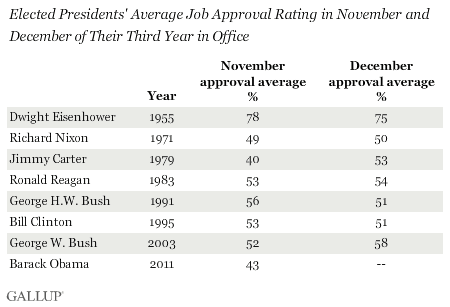PRINCETON, NJ -- President Obama's 43% average job approval rating last month ranks as one of the lowest for an elected president in November of his third year in office. Only Jimmy Carter had a lower rating, at 40%. But Carter's rating surged in late November 1979 because of a rally in support after the onset of the Iranian Hostage Crisis, and he averaged above 50% in December. All recently elected presidents were at or above 50% in December of their third year in office.

Obama's November average is improved from his 41% averages in August, September, and October, but looks weaker from a historical perspective. His job approval rating has been highly stable in recent weeks, but if it does not increase significantly this month, he will be the first elected president in Gallup records to be below 50% in December of his third year in office.
Though all recent elected presidents were at or above 50% 11 months before they faced re-election, the trajectory of their ratings differed.
- Dwight Eisenhower had approval ratings above 70% for the latter part of 1955.
- Richard Nixon's approval ratings were generally stable near 50% in late 1971.
- After the late November surge, Carter's ratings stayed high from December 1979 through February 1980, but by March 1980, he was back in the low 40% range.
- Ronald Reagan's approval ratings were improving in late 1983.
- George H.W. Bush's job approval was falling in late 1991 from the then-record-high 89% registered in early March after the Persian Gulf War ended, and it continued to decline to a low of 29% in August 1992.
- Bill Clinton's ratings were also generally improving in late 1995 before dipping below 50% in early January 1996, but then they bounced back above 50% by the end of January.
- George W. Bush's approval ratings were declining from his post-9/11 highs by late 2003, but he got a bump in support in December when the U.S. captured Saddam Hussein.
Carter and the elder George Bush are the two recent presidents who were defeated for election to a second term in office.
Obama's current ratings are closest to those of Gerald Ford, a president who was not elected in his own right but sought re-election. Ford's job approval rating averaged 43% in November and December 1975. Ford was narrowly defeated for re-election by Carter the following November.
The other two unelected presidents who ran for re-election, Harry Truman (54% in November-December 1947) and Lyndon Johnson (76% in December 1963), were above 50% roughly a year before facing voters for the first time. Johnson had just become president after the assassination of John F. Kennedy -- hence, his high approval ratings -- while Truman had been in office for nearly three years after Franklin Roosevelt's death.
Implications
Gallup finds that presidents are generally re-elected if their approval rating at the time of the election is at least 50%, though George W. Bush was re-elected with a 48% approval rating in 2004. Thus, Obama's current 43% job approval rating is not an encouraging sign for his re-election prospects.
At the same time, Obama remains competitive with Republican candidates in polls of registered voters' general election preferences.
Obama's campaign team can hope that the modest improvement in his November approval rating is the beginning of an upswing in his public support that would continue into 2012 and increase his probability of being re-elected.
Explore President Obama's approval ratings in depth and compare them with those of past presidents in the Gallup Presidential Job Approval Center.
Survey Methods
Results are based on telephone interviews conducted as part of Gallup Daily tracking Nov. 1-30, 2011, with a random sample of 14,687 adults, aged 18 and older, living in all 50 U.S. states and the District of Columbia.
For results based on the total sample of national adults, one can say with 95% confidence that the maximum margin of sampling error is ±1 percentage point.
Interviews are conducted with respondents on landline telephones and cellular phones, with interviews conducted in Spanish for respondents who are primarily Spanish-speaking. Each sample includes a minimum quota of 400 cell phone respondents and 600 landline respondents per 1,000 national adults, with additional minimum quotas among landline respondents by region. Landline telephone numbers are chosen at random among listed telephone numbers. Cell phone numbers are selected using random-digit-dial methods. Landline respondents are chosen at random within each household on the basis of which member had the most recent birthday.
Samples are weighted by gender, age, race, Hispanic ethnicity, education, region, adults in the household, and phone status (cell phone only/landline only/both, cell phone mostly, and having an unlisted landline number). Demographic weighting targets are based on the March 2010 Current Population Survey figures for the aged 18 and older non-institutionalized population living in U.S. telephone households. All reported margins of sampling error include the computed design effects for weighting and sample design.
The questions reported here were asked of a random half-sample of respondents each night on the Gallup Daily tracking survey.
In addition to sampling error, question wording and practical difficulties in conducting surveys can introduce error or bias into the findings of public opinion polls.
For more details on Gallup's polling methodology, visit www.gallup.com.
